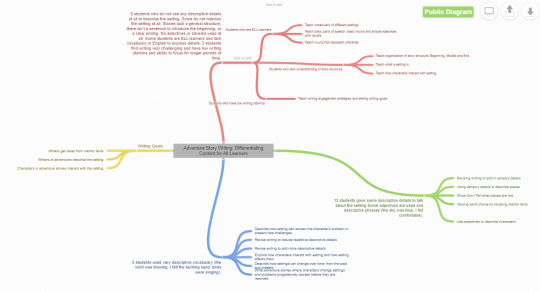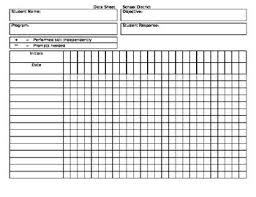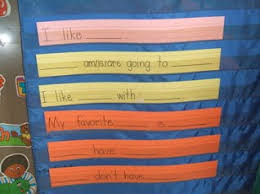Don't wanna be here? Send us removal request.
Text
Differentiated Learning
Grade 2 students are beginning a genre unit focusing on Adventure Stories. The primary writing goals are:
Primary Goals:
Writers get ideas from mentor texts.
Writers of adventures describe the setting.
Characters in adventure stories interact with the setting.
To assess readiness levels of students for this unit a pre-assessment is utilized.
Pre-assessment
Before writing about an imagined setting, students will be asked to write about a place that they know well where something has happened, “An Everyday Adventure.” The prompt is as follows:
Write about a place (setting) where you had an Everyday Adventure. Use words that describe to let the reader know what the place is like. Write about what you did in this place.
Rubric for pre-assessment- Six Traits Writing Rubric
(Particular focus is on organization of the recount, as well as the word choice employed to describe the setting.)

After the writing assessment, the results were as follows:
5 students who do not use any descriptive details at all to describe the setting. Some do not mention the setting at all. Stories lack a general structure, there isn’t a sentence to introduce the beginning, or a clear ending. No adjectives or adverbs used at all. Some students are ELL learners and lack vocabulary in English to express details. 2 students find writing very challenging and have low writing stamina and ability to focus for longer periods of time.
12 students gave some descriptive details to talk about the setting.Some adjectives are used and descriptive phrases (the sky was blue, I felt comfortable).
5 students used very descriptive vocabulary (the wind was blowing, I felt the burning sand, birds were singing).
This Flowchart shows how you might differentiate content based on these assessment data results:

To track the students’ learning, the 6 Traits Writing Rubric can be used again to see how the student is developing with regards to the standards.
Also, after the first pre-assessment, students can self-assess and set writing goals.

They can then use this self-assessment to measure their growth throughout the unit and modify their goals.
0 notes
Text
Project Based Learning
PBL projects focus on developing content knowledge and skills throughout real-life experiences as students engage in meaningful projects. PBLs focus on gaining knowledge through experiences, and then applying that knowledge within a project that tackles authentic problems and looks for real solutions. The projects are characterized by being personally meaningful to the particular group of students involved. There are typically 4 phases of the project:
1) The launch (entry event and driving question)
2) Building knowledge and skills
3) Developing products and answers to the driving question
4) Presenting products and answers to the driving question
Source: "Gold Standard PBL Videos | PBLWorks." https://www.pblworks.org/gold-standard-pbl-videos. Accessed 9 Feb. 2020.
An example of a KG class’ engaged in a PBL project following these 4 steps:
youtube
For more information on PBL please visit PBLworks.
Project Title: Boom Boom Flash! (Grade 1)
This is a PBL project. The goal is for students to learn about the scientific properties of light and sound and how they can be utilized to communicate emotions to a wider audience. The driving question of the projects asks:
“How can we use light and sound to communicate different kinds of feelings without words?”
The final product is for students to create performances or multimedia art that communicates an emotion or feeling using light and sound.
Description
Throughout the inquiry, students are given opportunities to explore and experiment with light and sound to discover some of their properties and to develop and understanding of some science standards, such as collecting evidence and making observations. They will also create a tool that allows them to communicate across distance.This understanding of the properties of light and sound, and design experience will support them in using light and sound to communicate an emotion with them. Beforehand, they will explore their own emotions as well as ways that emotions have been communicated in theatres, art, tv, etc to build their ideas. They will work in teams to communicate the chosen emotions through light and sound. The performances and/or artwork will be presented to family, friends and community members. Along the way they will keep a journal or blog to document their growing understanding and knowledge.
Standards:
Next Generation Science Standards
• 1-PS4-1: Plan and conduct investigations to provide evidence that vibrating materials can make sound and that sound can make materials vibrate.
• 1-PS4-2: Make observations to construct an evidence-based account that objects in darkness can be seen only when illuminated.
• 1-PS4-3: Plan and conduct investigations to determine the effect of placing objects made with different materials in the path of a beam of light.
• 1-PS4-4: Use tools and materials to design and build a device that uses light or sound to solve the problem of communicating over a distance.
Common Core State Standards ELA—Literacy
• SL.1.1: Participate in collaborative conversations with diverse partners about grade 1 topics and texts with peers and adults in small and larger groups.
• SL1.5: Add drawings or other visual displays to descriptions when appropriate to clarify ideas, thoughts, and feelings.
• W.1.6: With guidance and support from adults, use a variety of digital tools to produce and publish writing, including in collaboration with peers.
National Core Arts Standards —Media Arts
• Cr2.1.1: With guidance, use identified ideas to form plans and models for media arts productions.
• Pr5.1.1.c: Experiment with and share different ways to use tools and techniques to construct media artworks.
Project Sourcehttps://drive.google.com/file/d/13ZrR0JgxC63bL_-vIgMKH3eK-1BSU4WH/view
Rubrics



I struggled with making the rubric as, while i made it in student-friendly language, I found myself making the difference between the areas as quantitative points (I used 3 tools, I used 4 or more tools, etc.) as opposed to a qualitative difference in their understanding. I found it hard to write a student-friendly rubric that assessed for this.
Monitoring and Feedback
There will be 4 formative assessment types that will be used in the beginning and mid project. If more is required they can be implemented more regularly, depending on need.
Focused observations During the initial experiments with light and sound, students will be assessed for how they are able to participate in discussions. This will be done by focused observations. Focused observations will allow the teachers to check in on talking time, questions being asked, and active listening. This will be assessed again during the emotions discussions later on.
Checklists will be used to assess students ability to carry out experiments. This will happen during initial experiments on sound and later ones on light. These checklists will be used to support students needing it on creating experiments and carrying them out.
Conferencing Again, this happens twice to allow for a chance for students to grow from teaching points highlighted after the first assessment. The conferencing is based on revisions of the journals. What does the teacher notice about their journals? What can be improved?
Video Diaries These are taken throughout. Students share their creative ideas for the project, what they might try out the next day, or wonderings they have, or what they learnt from others that day through observations or discussions.This can be used to assess creativity and collaboration skills. They also can be used as a reflection tool throughout about process.
Feedback and Reflection
Feedback and reflection will be encouraged throughout, through the journals and video diaries. Teacher feedback will be given throughout, in the conferencing sessions as well as notes in journals. Small groups will be pulled based on information from checklists about understanding of experiments and communication skills.
In the final evaluation of the project it will be important for students to self-reflect using the rubric provided. They will also look through their video diaries to identify the challenges along the way and how they surmounted them. I will model the process of reflection with Think Alouds and through reflecting as a class on other classroom moments that aren’t related to the project.
0 notes
Text
Formative Assessment Design
Designing useful formative assessments isn’t as quick and easy as the ubiquitous exit ticket or think-pair-share. For a formative assessment to really serve its purpose, to inform the teaching and learning process, the assessments need to be well thought out, expertly executed, and well documented and then actioned. From the research I have done, many teachers, including myself, have fallen into the trap of using formative assessments, but having difficulty organizing and taking action on the data.
youtube
Through designing 3 formative assessments, Think-Pair-Share, a Kahoot Quiz, and Explain What Matters I have come away with these key takeaways:
1) Planning the formative is key. Formative assessments are not an afterthought or a quick check-in (although there are cases where sometimes they can be that). Although the assessment is quick, to be effective it needs to be purposeful and planned so that you are aware of what you are looking for.
2) How will you record your data? Although the information that formative assessments give you are very interesting at the time, they are not very valuable if you don’t do something with it intentionally. There needs to be a follow up. To do this you need to have data to look at and make decisions from. This moves you from “I have a general idea of where my class is at,” to “This is what I will teach to move them forwards.”

3) Formative assessments are learning moments for students. Many formative assessments ask students to execute tasks that require critical thinking, such as synthesizing information and forming ideas. Allow sufficient time to draw out deeper thinking for these tasks.
5) Formative assessments are great moments to document students’ thinking. Take advantage of these moments to write down quotes that can be drawn upon on the next lesson, or to create understanding amongst the classroom about the learning process and knowledge being created.
6) For formative assessments to work well they need to be taught. Giving feedback fro 3 Stars and a Wish, or effectively listening in a Think-Pair-Share, all need to be explicitly taught to allow students to benefit from them. The more they are practiced, the more efficient they become.


The assignments this week highlighted how much language is a part of so many assessments we do Therefore, we need to be always looking for ways to differentiate for the different aspects of language (reading, writing, listening and speaking). The formative assessment strategies that I use in my classroom are ones that require a lot of synthesis and organization of ideas. The feedback from my partner, plus research that I read, led me to modify my assessments in order to scaffold them and allow for greater success. These supports can help:
1) Visual Word Walls

2) Sentence Frames

3) Sketching Ideas

4) Recording Thinking using Digital Apps

The independent research on different types of formative assessment strategies was helpful to learn different types of quick formative assessments.
10 Assessments You Can Perform In 90 Seconds
22 Easy Formative Assessment Techniques for Measuring Student Learning
The feedback from my classmate gave me ideas of how I could further differentiate the formative assessments, by using visual word banks and partner work. I improved the formative assessments that I currently do by crafting questions that are better designed to elicit the learning outcomes. The readings and feedback also caused me to focus more on how am I collecting data purposefully from the assessments that I cam continually undertaking in class.
In the future, it is the data collection piece that will need to be improved in order to better inform the future instruction, which is the focal point of formative assessments themselves.
References
(2019, September 30). Think Pair Share...Gives Voice! - CT3. Retrieved February 1, 2020, from https://www.ct3education.com/2019/09/30/think-pair-share-gives-voice/
(2017, August 23). 10 Assessments You Can Perform In 90 Seconds. Retrieved February 3, 2020, from https://www.teachthought.com/pedagogy/10-assessments-you-can-perform-in-90-seconds/
The Formative Classroom. Retrieved February 2, 2020 from https://www.youtube.com/watch?v=rL54bfmZPzY
(2013, July 12). 22 Easy Formative Assessment Techniques for ... - NWEA. Retrieved February 3, 2020, from https://www.nwea.org/blog/2013/22-easy-formative-assessment-techniques-for-measuring-student-learning/
1 note
·
View note